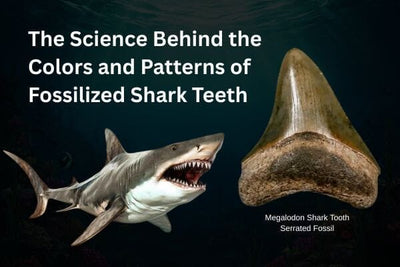Shark teeth always get people’s attention. Many people enjoy looking at them due to their sharp edges, bright colors, and unique mineralized fossils found in every tooth. Each shark tooth originates from ancient oceans and regions rich in minerals. There have been numerous chemical changes over time. If you understand the science behind colors and shapes, you will appreciate your collection more. You will also understand it better.
How Fossilization Shapes Shark Teeth
Fossilized shark teeth happen when the enamel and dentin that were there at first get swapped out by minerals as years go by. This process takes several steps:
-
Burial: Sharks lose their teeth, and the teeth sink into the sediment.
-
Mineral Replacement: Over time, minerals such as iron, manganese, and phosphate replace organic matter in the teeth.
-
Compaction: Many layers of sediment press down on the teeth. This helps keep the teeth in shape.
This change keeps the tooth’s shape. It also features special chemical marks that alter its color and extend its lifespan.
Common Colors and What They Reveal
Shark teeth can come in many colors. You may see shades of black, brown, gray, blue, or even red. This happens because the teeth absorb minerals as they turn into fossils.
-
Black teeth: These contain a high amount of phosphate and organic carbon.
-
Brown or reddish teeth: This color indicates the presence of iron oxide.
-
Blue or gray teeth: This indicates that manganese has entered the body.
-
White or tan teeth: These teeth have not undergone significant mineral changes, or they have been exposed to some sediments.
Each color provides a glimpse into the geochemical environment in which the tooth was located in ancient times.
Understanding Fossil Patterns
Beyond color, many shark teeth exhibit fossil patterns, including lines, ridges, and small grooves. These things often come from:
-
The first shape of the shark tooth for that kind of shark.
-
How the dirt pushes down, and the way the grains are facing.
-
Germs work during the first part when fossils start to form.
Seeing the way these patterns appear can help people who collect or study fossils identify the type, age, and location where the shark lived a long time ago.
Factors That Affect Tooth Appearance
Many things on Earth and in the environment can also change how fossilized shark teeth look in the end:
-
Sediment composition: Mineral-rich clays or sands can change the color.
-
Water chemistry: Salinity and pH influence the accumulation of certain minerals.
-
Time: A longer period for fossilization can result in deeper and brighter colors.
-
Diagenesis: Chemical changes that occur after burial can alter the color, making it stronger or different.
Knowing these things helps people read a tooth's history. It also allows people to verify its authenticity.
Using Shark Teeth as Scientific Tools
Fossilized shark teeth are not only things you can collect. They also provide proof of how sharks have changed over time.
-
Show what an animal ate by looking at the shape and wear of its teeth.
-
Find out where animals moved by studying the types of elements in their teeth.
-
Help tell how old the layers around the fossils are, which helps us understand other fossils.
Gathering these teeth in the right way enables people to contribute to paleontological work. At the same time, they can appreciate the beauty of nature.
Presrving and Appreciating Fossilized Shark Teeth
To keep the colors and patterns looking good, you need to take care of them:
-
Do not use a strong cleaning product
-
Keep in places that are steady and dry. There should be little light in the area.
-
Always use gloves while touching them. This will stop oils from making the surface look dull.
Each tooth, no matter if it is black, brown, or blue, tells a clear story of the ancient seas. These teeth also reveal how large animals in the past hunted one another.
Explore Authentic Fossilized Shark Teeth with Fossil Age Minerals
At Fossil Age Minerals, collectors get real and well-chosen fossil shark teeth. Each one has its history and info to help you learn. This makes your collection both visually appealing and scientifically backed.
Step into a world from long ago and start your collection now. You can feel sure about what you buy.


